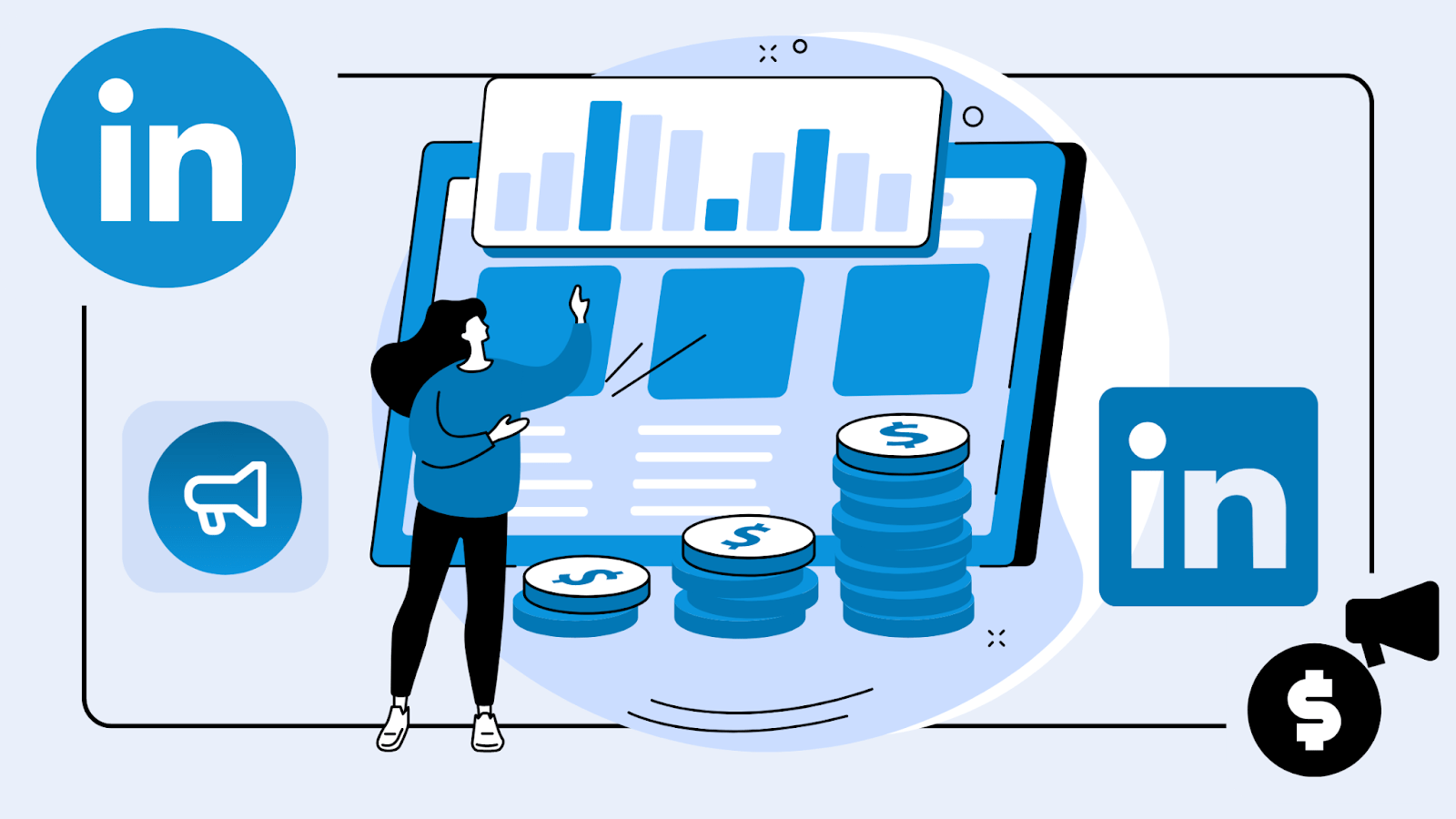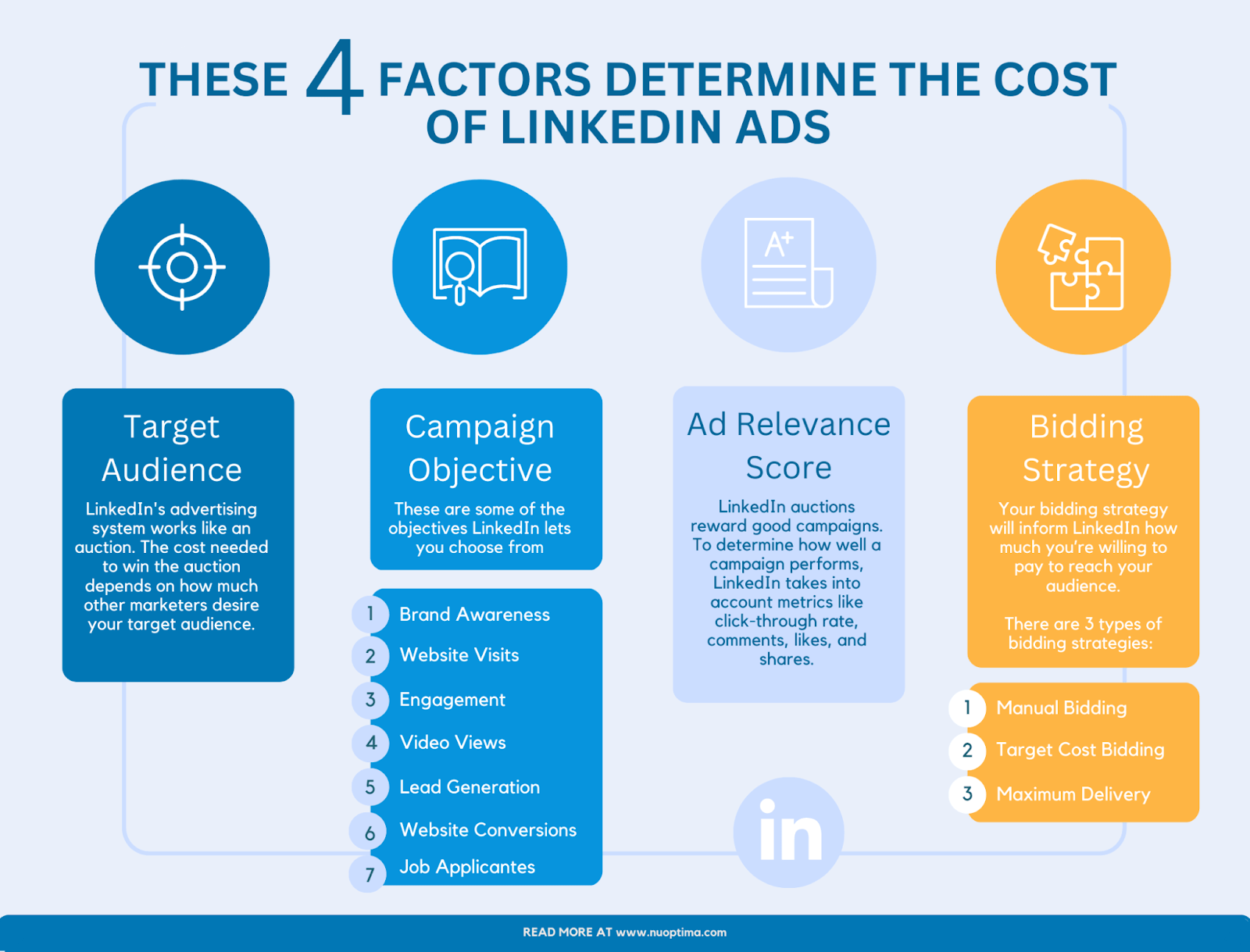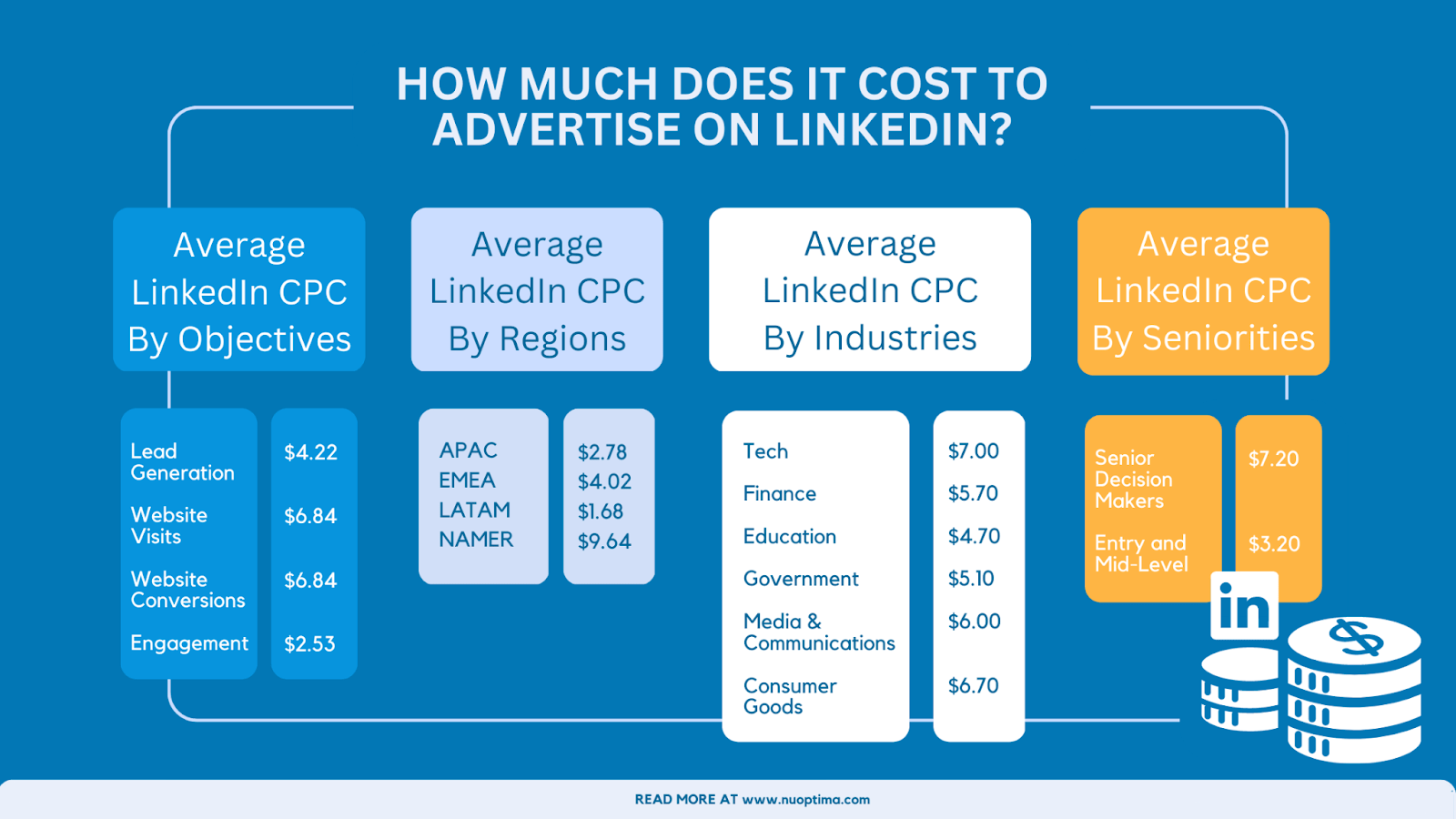
You might be aware that an online auction mechanism sets the cost of advertising on LinkedIn. But did you know that your ad may not be shown even if you have the highest bid?
This blog article will review how LinkedIn advertising works and which budget you’ll need to advertise successfully on LinkedIn this year. Prepare to find answers to questions like:
“How much does LinkedIn charge per 1,000 impressions?”
“What is the minimum budget for LinkedIn?”
“How well do LinkedIn ads work?”
We’ll also provide some pointers and methods to help you get the most out of your LinkedIn advertising budget.
Key Points
- LinkedIn’s advertising model is based on a bidding system, where advertisers compete with each other to reach the same audience.
- The cost of advertising on LinkedIn depends on several things, such as the audience, the campaign’s goal, and the bid. On average, the cost per click (CPC) on LinkedIn is $5.58, the cost per 1,000 Impressions (CPM) is $33.80, and the cost per send (CPS) is between $0.20 and $0.80.
- To begin advertising on LinkedIn for any ad style, advertisers need a daily budget of at least $10. A new campaign that hasn’t yet begun must have a minimum budget of $100.
- After the campaign is underway, the minimum lifetime budget is replaced with a minimum daily budget of $10 multiplied by the number of campaign days. For CPC and CPM campaigns, LinkedIn requires businesses to bid at least $2.
- LinkedIn is a popular social network used by over 850 million professionals. By hiring a B2B lead generation agency, you can effortlessly target many of these professionals. This platform also offers a variety of advertising options and uses objective-based advertising, making it an effective tool for reaching your target audience.
How Does Advertising on LinkedIn Work?
Because advertising on LinkedIn is so popular, it doesn’t use a fixed price, but rather a bidding model. An auction mechanism calculates an overall score by multiplying the bid price and relevance score. Based on that, LinkedIn decides when and how much to charge you for the ad.
Essentially, you compete with other advertisers with a similar ad format and target group.
These Four Factors Determine The Cost of LinkedIn Ads
As an advertiser on LinkedIn, it’s crucial that you determine a budget, establish a schedule, and set a bidding strategy to keep track of how much you spend on your campaign.

According to LinkedIn, four factors determine the price you pay for your ads. Let’s take a look at them in more detail:
1. Target Audience
As we’ve mentioned before, LinkedIn’s advertising system operates as an auction. You bid against other advertisers who target the same audience. The expense necessary to win the auction depends on how much other marketers desire your target audience.
In other words, the price goes up as demand (advertisers) rises above supply (audience).
2. Campaign Objective
Your campaign will be priced per your campaign objective and the bid strategy you choose.
That means there are various marketing objectives, each with a different pricing model. These are some objectives LinkedIn lets you choose from:
- Brand Awareness
- Website Visits
- Engagement
- Video Views
- Lead Generation
- Website Conversions
- Job Applicants
3. Ad Relevance Score
LinkedIn auctions reward relevant and engaging ads with a high campaign quality score. As the score rises, your ad cost will decrease.
LinkedIn considers metrics like click-through rate, comments, likes, and shares to determine how well a campaign performs.
4. Bidding Strategy
Your bidding strategy will inform LinkedIn how much you’re willing to pay to reach your audience. LinkedIn operates its auctions on a “second-price” model, meaning you will only spend one cent extra if you outbid the competition.
There are three types of bidding strategies: Manual bidding, Target cost or cost cap bidding, and maximum delivery bidding. We’ll dive into each of these in the following section.
How to Choose the Right Bidding Option for Your LinkedIn Advertising Campaign
As mentioned before, the bidding strategy you select for your campaign will influence how much you pay per key result.
While automated bidding is easier, other options may be more cost-effective for your campaign.
Manual Bidding
Manual bidding allows you to specify the maximum amount you are willing to spend on each bid, allowing you to better control your budget when bid prices vary.
This option allows you to set a price for each click, per mille impressions, and each send. If you want maximum control over your bid in the ad auction, this is the best option.
Target Cost
In this option, you can set the maximum cost per action (CPA) you’re willing to pay. Then, LinkedIn adjusts your bid automatically based on your target bid price.
If you have a clear goal in mind, target cost is an excellent choice since it allows you to determine how much you spend towards that goal.
Maximum Delivery
This method uses automatic bidding to keep your campaign competitive in ad auctions. It is intended to optimise marketing outcomes while using your entire budget.
If you dispose of a high daily budget, max delivery will spend your budget faster for maximum results.
This is a fantastic strategy if you only have a little time to improve and want speedy results. The max delivery option may also be used to automate bid management.
LinkedIn Ad Pricing Models
LinkedIn has three different ad pricing or bidding options. Let’s look at them in detail and see which ads they’re appropriate for and how much these ads on LinkedIn cost.
Cost per click (CPC)
You are charged a fee for each click on your ad. This is an excellent option if you want to attract substantial traffic to your website and generate leads.
LinkedIn’s average CPC (cost-per-click) is roughly $5.39. This may be a little pricey, depending on your budget, but remember that these clicks originate from individuals that may quickly convert into qualified leads.
Cost per click may be used in both Sponsored Content and Text Advertising. Since you pay for each click, these campaigns are designed to drive people to your website or landing page through text, video, and single-image ads, amongst others.
Cost per impression (CPM)
In this pricing model, you are charged a price for every 1,000 impressions – or “mille”, thus the “M” in “CPM”.
Every time someone sees your ad, this counts as one impression. Since you’re just paying for people to look at your ad and not engage with it, this modality is called “pay-per-view”.
The goal of CPM or cost per impression LinkedIn ads is to drive brand awareness. You may use them to get your name out there before you start generating leads. This makes CPM campaigns a perfect alternative to cost-per-click ads.
The average cost per thousand impressions (CPM) for LinkedIn ads is $6.37. You may think you’re spending more, but in the long run, you’ll spend less than you would with cost-per-click (CPC) advertising since you’re only paying for views, not clicks.
Compared to single-image ads or text ads, CPM performs better for videos. That is because all you have to do is pay for people to view your videos without asking them to do anything in exchange.
Cost per send (CPS)
With this type of advertising, your information goes straight to the LinkedIn mailbox of potential leads. For each InMail sent, you pay a fee.
InMail marketing is ideal for bottom-of-the-funnel marketing, that is, targeting people who are familiar with the business and may be interested in what you have to offer. Although rather costly, the average fee of $0.70 per InMail sent, is justified in order to directly contact your target demographic.
This pricing model has a lot of promise, but it can also go horribly wrong. Since these are direct messages, any mistake can be magnified, especially if you don’t target the proper people or if your message is unclear.
How Much Does it Cost to Advertise on LinkedIn?
TheB2BHouse gives an excellent overview of the different average costs of advertising on LinkedIn. To get a more accurate idea of your cost of advertising on LinkedIn, jump to the last paragraph of this section.

Average LinkedIn CPC By Objectives
LinkedIn prices each marketing objective differently. For example, brand awareness campaigns are priced based on impressions, while lead generation campaigns are priced based on clicks.
These are the average LinkedIn CPC for different marketing goals:
- Lead Generation: $4.22
- Website Visits: $6.84
- Website Conversions: $6.84
- Engagement: $2.53
Average LinkedIn CPC By Regions
Generally, business structures are divided into four geographies, which marketers must bear in mind when targeting their advertising campaigns. The average CPC by region is shown below:
- APAC: $2.78
- EMEA: $4.02
- LATAM: $1.68
- NAMER: $9.64
Average LinkedIn CPC By Industries
There is no other platform that offers this breadth and depth of professional demographics.
If you’re planning to market to any of the sectors listed above, improve your understanding of average ad pricing with the examples below:
- Technology: $7.00
- Finance: $5.70
- Education: $4.70
- Government: $5.10
- Media & Communications: $6.00
- Consumer Goods: $6.70
Average LinkedIn CPC By Seniorities
Above all, ads on LinkedIn are here to influence decision makers. As many marketers compete for the same audience, the price rises. Consequently, it’s no wonder that advertising to top decision-makers, including CXOs, VPs, Directors, Partners, and Owners, costs more than twice as much.
These are the average CPC for different seniorities.
- Senior Decision Makers: $7.20
- Entry & Mid-Level: $3.20
A More Accurate Cost of Advertising on LinkedIn
Using averages is a great way to get an idea of the budget you might need. However, you’re still only looking at things from a distance. Putting your strategy into action requires more accurate, real-time information.
Using LinkedIn’s forecasting tool in your campaign manager is a better way to estimate your costs.
Head to “Campaign”, then select your markets and target audience. Scroll down to “Budget & Schedule” and check your CPC and CPM.
On the right-hand side, you find the forecasted results for a 1-day, 7-day, or 30-day range.
How to Control Advertising Spend
Each ad type on LinkedIn requires a minimum daily budget of $10 to get started. For fresh, dormant campaigns, the lifetime budget minimum is $100. The minimum lifetime budget changes after the campaign opens to a minimum daily budget of $10 multiplied by the number of campaign days.
And while LinkedIn’s price is reasonable compared to the other major social networking sites, it is still too expensive for many small businesses’ marketing budgets.
Fortunately, LinkedIn gives you three ways to control how much you spend on ads:
Lifetime or Total budget
For campaigns that aim at immediate results, it’s ideal to set a total budget to control ad spend.
Suppose your consulting business temporarily provides new customers with a sign-on bonus.
The minimum lifetime budget for a new, inactive campaign is $100. You define the number of days your campaign is set to run. Once the campaign starts, the minimum goes up to $10 times the number of days for which the campaign is scheduled.
Daily budget
If you’re planning on running a campaign for a prolonged period of time, for instance, to continuously promote your law firm’s legal specialisation, running a campaign on a daily budget would be the most cost-effective.
The minimum expenditure in this option is $10 per day.
Campaign Groups
The third option to keep your ad spend under control is to specify a budget for a campaign group. As soon as the budget is exhausted, all campaigns in the group will be put on hold.
Set bids
The maximum spending limit can be set for impressions, clicks, and other variables. Keep in mind that there is a minimum bid of $2 for each click.


